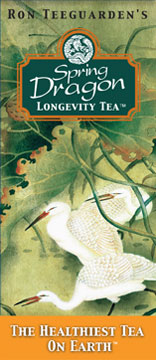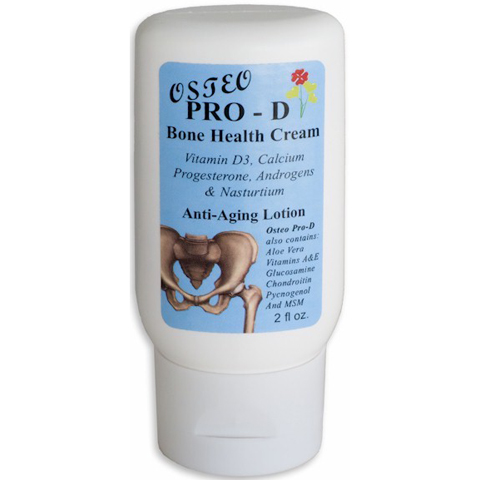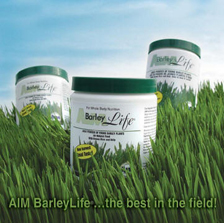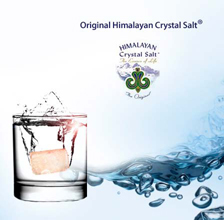Osteo Pro-D Bone Health Cream - 2 fl oz.
OSTEO PRO-D Bone Health Cream is the only bone health cream to combine Vitamin D3, Calcium and Progesterone. It is formulated to reverse bone loss, increase lean muscle mass and support joint, tendon and ligament health. While Vitamin D3, Calcium and Progesterone are proven to slow bone loss, there are only two things proven to build bone - exercise and progesterone. Osteo Pro-D contains the maximum allowable amount of progesterone along with 500 IU of Vitamin D3. It also increases androgen levels which build lean muscle mass so you can exercise. It includes MSM, Glucosamine & Chondroitin for connective tissue as well as antioxidants Pycnogenol, Vitamins A & E in an Aloe Vera base.
Osteo Pro-D is a skin cream formulated to slow bone loss - resorption and increase the building of bone formation - deposition. It contains Vitamin D3 and calcium. It also contains the maximum allowable amount of progesterone with Chrysin an androgen stimulator and estrogen regulator. When taken nightly and combined with exercise one can expect a whole host of benefits. Two things build bone weight bearing exercise and progesterone. Osteo Pro-D has androgens to build lean muscle mass so you can exercise more. It also has the ingredients for stronger bones. It has plenty of high quality antioxidants and many of the ingredients are anit-inflammatory. We also added glucosamine, chondroitin and MSM to strengthen the tendons and ligaments that make up the connective tissue that is between your new muscles and stronger bones. Osteo Pro -D is a significant development in the fight against bone loss, anti-aging and is a significant contribution to women's health.
The importance of Vitamin D
Progesterone and Androgens raise libido and Osteo Pro-D has great anti-aging properties because many of the ingredients are anti-inflammatory. Vitamin D3 has gained a lot of notoriety as of late because of its many health benefits. New discoveries seem to take place daily, and many of them relate to bone health. Vitamin D is essential for promoting calcium absorbtion in the digestive tract and maintaining blood calcium and phosphate levels sufficient to enable bone mineralization and prevent bone loss known as osteoporosis. Vitamin D is also needed for bone growth and bone remodeling. Remodeling consists of new bone cell formation by the osteoblasts and removal of old bone cells by the osteoclasts. There are very few dietary sources of Vitamin D. Cod liver oil is one of them. Fortunately for our taste buds the body manufactures Vitamin D when the skin is exposed to the UVB spectrum of sunlight. This requires a minimum level of UVB to take place. That level for most latitudes in the US is from May to September from eleven in the morning to three in the afternoon - the time when most of us are wearing sunscreen. A sunscreen with an SPF of 8 is supposed to absorb 93% of UVB and doubling the SPF to16 filters out 99%. Is it any wonder over 80% of the population is Vitamin D deficient?
So what are we to do in order get the 1000 - 2000 IU of Vitamin D daily that most practitioners recommend? The answer is supplementation. Vitamin D supplementation comes with benefits. Studies show that in addition to bone health Vitamin D can improve heart health, prevent many cancers, alleviate skin disorders and reduce the risk of diabetes. Studies have shown that 1000 IU per day can reduce the risk of cancer by up to 50% and 2000 IU per day can reduce the risk of upper respiratory disorder in the elderly by 90%. Vitamin D, since it is created by the skin is absorbed most efficiently by the skin. For example 500 IU taken in the form of a skin cream is equivalent to 2000 IU taken orally.
Calcium & Vitamin D3 Work Together
For decades people have known about the connection between calcium and bone health. Most doctors recommend between 750 milligrams and 1500 mgs daily to promote bone health. For all of its importance nearly every recommendation for calcium supplementation to prevent bone loss includes Vitamin D3. They work together. A number of large studies conducted over the years showed that supplementation with Vitamin D3 and Calcium can reduce bone loss by up to 50% and cut the number of hip fractures in half. Is simply slowing the rate of bone loss enough? Wouldn't it be nice if we could reverse bone loss and actually build bone to replace what has been lost? Even a mild Vitamin D deficiency can lead to bone loss. Osteoporosis is a major public health threat which afflicts 55% of the population that is over fifty and four out of five of those are women. That means that nearly thirty seven million American women over fifty have osteoporosis and nearly all have bone loss.
There are one quarter million hip fractures annually and 23 million women over 50 have had at least one vertebral fracture. Bones are constructed of two textures of cells the sponge like bone in the ends of long bones and vertebrae is called trabecular bone and the hard outer shell of bones is called cortical bone. The spongy part is more subject to bone turnover and remodeling thus making bones with more trabecular tissue more susceptible to fracture as in the wrist, hip and spine.
To maintain and improve Bone Mineral Density studies have shown that aerobics, weight bearing and resistance exercise are effective. In addition to exercise, US Health Agencies recommend 1,2000 mg. of calcium per day and a minimum of 800 IU of Vitamin D daily. Peak bone mass is reached around age 21 in women. After that it starts to decline. The underlying mechanism behind osteoporosis is an imbalance between the destruction of old bone cells (resorption) and their replacement by creation of new bone cells (formation). At any given time up to 10% of your bone mass may be undergoing this process, known as remodeling. Old bone cells are destroyed or resorbed by osteoclasts and reformed by osteoblasts. Osteoporosis can simply be described as excessive bone resorption and inadequate formation of new bone cells resulting in a net reduction in Bone Mineral Density leading to weaker bones. Yet osteoporosis can be prevented with lifestyle change and supplementation that includes Vitamin D and Calcium.
Healthy Lifestyle Equals Healthy Bones
Lifestyle change can be summed up in two words - diet and exercise. With its anabolic effect, exercise may simultaneously stop and reverse osteoporosis. In adults physical activity helps maintain bone mass and can increase it by 1-2% annually.
Estrogen, Androgens and Progesterone
Your body has other mechanisms that assist in bone health, hormones being among them. There are three very important hormones that are required for bone health that diminish rapidly as we age. They are estrogen, androgens and progesterone. Estrogen is a very powerful antiresorptive agent. It prevents resorprtion or bone loss. Unfortunately estrogen supplementation is highly controversial because the replacements are synthetic and are suspected of causing complications like breast cancer, which is why synthetic estrogens are generally in direct opposition to those individuals who are predisposed to natural healing.
Androgens are the hormones that drop the most as we age, they are little known, but unbelievably important. They are responsible for building lean muscle mass. If we could get our lean muscle mass back, our skin would not sag and we'd have the strength to engage in the weight bearing exercises that are all important in reversing bone loss like walking, running, dancing and aerobics. As a bonus when your body is finished building muscle with androgens it aromatizes them into estrogen - a most potent antiresorptive agent. As such, androgens provide for much needed muscle mass, and a natural endogenous source of needed estrogen.
Progesterone is plentiful in young women, and is a hormone that nearly disappears in perimenopausal and menopausal women. Progesterone is also one of the only substances proven to build bone. It increases new bone growth and BMD. In one study progesterone increased bone mass on average by 3-4% per year over a three year period. Progesterone also hydrates the skin and alleviates many of the symptoms of PMS and menopause. Like androgens, progesterone also boosts libido.

Family Health News
Since 1990 Family Health News has been headquarters for health conscious individuals worldwide. We provide informative articles on important health topics to doctors and lay people alike in a thorough, well written, understandable way.
At Family Health News we believe that a person’s health is their personal responsibility and beyond that it is an opportunity. We live in an era of unlimited possibilities. Family Health News provides access to the information and resources necessary to incorporate health and vitality into your lifestyle in a time efficient, cost effective way. To eschew this opportunity would be beyond irresponsible – it is a travesty.
If you’re sick and tired of being sick and tired, take charge of your health and enjoy some vitality. Take the time and energy to take care of yourself – we make it easy. You’ve earned it and you deserve it.





